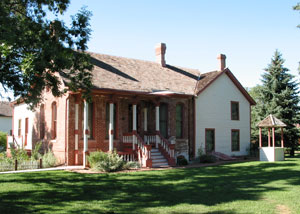Four Mile Historic Park
When I give a house tour, I always say, “This is a museum. What’s the rule?” “Don’t touch!” is their response. All through the house I have to remind them, “Don’t touch.”
I work part time at Four Mile Historic Park. I help with elementary school field trips and birthday parties. Four Mile was a stagecoach stop on the Cherokee Trail from the 1859 Pike’s Peak Gold Rush until the railroad came to Denver in 1870. It is four miles from the Intersection of Colfax Avenue and Broadway, where the Colorado State Capitol building stands.
The Cherokee Trail came down Cherry Creek to Denver, then went north to close to the Wyoming border, then west to Fort Bridger and on to California. The stage line came west from Leavenworth, Kansas on the Smoky Hill Trail across Kansas to where Limon now is. It then came across present Elbert County and down Smoky Hill Road to the Cherokee Trail and Denver.
The Four Mile station operated from 1859 to 1870 when the railroad came down to Denver from Cheyenne. It then was a farm and informal neighborhood center until around 1940. Today it is owned by the City of Denver and operates as a nonprofit.
The original house dates to 1859 and is the oldest standing structure in Denver. It is the museum I referred to in the first paragraph. We have horses and wagon rides, a stagecoach and several other wagons. There are goats, chickens, a tipi, a trapper’s cabin, wells, barns, gardens, and lots of places to picnic.
Our goal with school trips is to give students a taste of life in the nineteenth century. They are often shocked to find out that people managed to survive without iPads. Another goal is for them to have fun doing some of the things children did in the 1860s. They cook over an open fire, make butter, feed chickens, wash clothes in the washtub, pan for gold (fool’s gold), and play some pioneer games.
I tell stories about my pioneer family, tell them that the horses favorite food is third graders, that trolls live along the creek, and that the children emptied the chamber pots, brought in firewood, carried water, gathered buffalo chips for fuel on the trail, and fed the animals. Yes, they get some tall tales as well. Second graders are too little, fourth graders are too tough, but third graders are just right for horse food. I tell the girls the secret: “Girls are smarter than boys.”
Four mile is a fun place to work and the kids make it so. Of the hundreds of kids I have worked, only two seemed like they were headed for big trouble. I have as much fun as they do.

